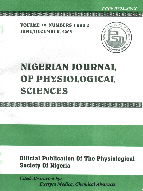
|
Nigerian Journal of Physiological Sciences
Physiological Society of Nigeria
ISSN: 0794-859X
Vol. 28, No. 1, 2013, pp. 57-62
|
 Bioline Code: np13010
Bioline Code: np13010
Full paper language: English
Document type: Research Article
Document available free of charge
|
|
|
Nigerian Journal of Physiological Sciences, Vol. 28, No. 1, 2013, pp. 57-62
| en |
Visual indices of motor vehicle drivers in relation to road safety in Nigeria
Emerole, C. G. & Nneli, R.O.
Abstract
This study assessed the visual profile of motor vehicle drivers in Owerri, Nigeria and to analyse the relationship between the various aspects of visual function in relation to road safety. A cross-sectional descriptive study of 150 commercial vehicles drivers and 130 private vehicles drivers was conducted between November 2005 and February 2006. Data were obtained using structured interviewer administered questionnaires and clinical examination was done. Standards procedures were used to determine visual indices. Data from the better eye (eye with a better visual acuity according to international and national standards) were reported, except in the analysis of near vision of the respondents. Twenty percent of the study group had normal visual acuity of ≥6/6 compared with 46.2% in the control group. The tonometric value in 88.0% and 93.1% of study and control groups respectively was less than 24mmHg. Both groups (96.8%) had normal confrontation visual field while 95.3% of study group and 97.7% of control group had normal colour vision. The most prevailing eye conditions that may reduce visual acuity were pterygium (51.3% in study group and 13.8% in the control group), retinopathy (16.7% of study group and 6.2% of control group) and glaucoma (12.0% and 6.9% of study and control groups respectively). Nineteen percent of the study group had regular eye examination compared with 38.5% in the control group. Alcohol consumption was 64.7% in the study group and 32.3% in the control group. Most of the commercial motor drivers in Owerri, Nigeria did not meet the Federal Road Safety Commission visual acuity standard for commercial motor drivers. Visual impairments and poor visibility are strongly associated with RTA among Nigerian motor vehicle drivers. Visual acuity and visual health care were poor among commercial motor drivers. There is need for renewed efforts to enforce a compulsory periodic visual examination for drivers, and to ensure that visual requirements for driving are met.
Keywords
Drivers; Visual acuity; Road safety; Road traffic accidents; Nigeria
|
| |
© Copyright 2013 - Physiological Society of Nigeria
|
|
